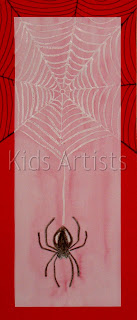- white drawing sheet A4 size
- tissue paper in different colours
- brush
- can with water
With tissue paper you can make beautiful flowers without painting! In this lesson I chose anemones, but any flower will work. To make an anemone, fold a tissue paper three times until you have a rectangle. This rectangle has six lows now. Cut two petals out of this rectangle; this makes twelve petals totally. Six petals make one anemone. Cut petals from different colours tissue paper. Cut small and bigger ones. Take the white sheet and wet the place for the first flower with a brush. Put the petals one by one around an imaginary white circle (this is for the heart of the flower) on the wet spot. The petals will tighten themselves on the wet drawing sheet. Stich all petals this way. Overlap is allowed, working on the edge too. Cut little circles (flowerhearts) out of black tissue paper and stick them with water. The tissue paper has started 'bleeding' yet. The brighter the colour of tissue paper, the better it bleeds. Light colors bleed less. The colours of the tissue paper will blend together. If all is well, you'll see rays from the black heart into the petals. If not, wet the flowers again with a brush and water. Be careful, petals might shuffle. Let the artwork dry a little. When it's still moist a bit, pull of all petals. Your beautiful anemones are ready!




.jpg)


































